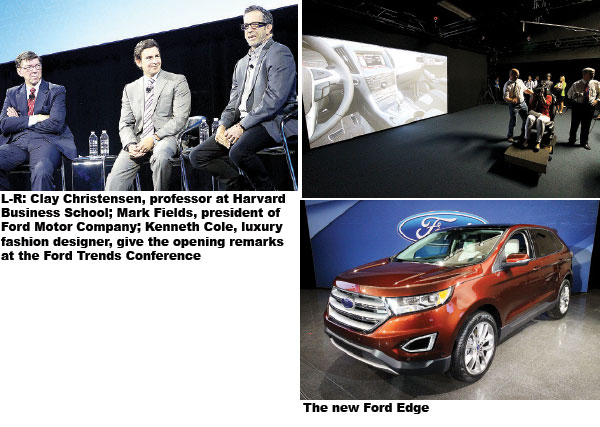Going Further: Ford looks into the future at their annual Trends Conference
DEARBORN, Michigan—“Innovation, by nature, is disruptive. If you can build upon an existing set of gears and everything is working smoothly, then you’re not revolutionizing yourself enough,” said Clay Christensen, a professor at the Harvard Business School and one of the most influential business thinkers in the world, as he opened the annual Ford Trends Conference. He shared the stage with world-renowned American designer Kenneth Cole, with the latter ending the night with a simple yet profound statement: “Today, companies do a lot of similar products, but what sets a great company apart is a powerful brand.”
It’s not every day you get to sit in a conference that details where a company is headed to in the near future; and it’s certainly not every day you attend an automotive one without even the word “car” mentioned once. Yet, this is exactly how Sheryl Connelly wants it. Ford’s Global Trends and Futuring Expert (yes, such a position exists) looks at what engineers, designers, and even marketers fail to see. Though there is no crystal ball, Connelly looks at things issues that cannot be controlled by the automotive industry and yet can affect it. She studies issues such as technology, economy, environment, and even politics to see how it affects trends in the automotive industry; for a trend is a permanent shift in perception and not just a passing fad. At any given time, Connelly identifies 200 different trends which can, in turn, be clustered in ideas. It’s these ideas that can and will affect car sales in the foreseeable future. At the 2014 Trends Conference entitled, “Further with Ford”, these major ideas have been identified: “Female Frontier”, “What’s the Big Deal with Big Data”, and “Decoding Design”.
 Female frontier
Female frontier
The glass ceiling above women may not be shattered yet, but the spotlight is certainly shining on it. Today, there are demographic shifts that are changing household dynamics and definitions, where women are continuously redefining their roles and responsibilities. As the world shifts from a manufacturing to a more knowledge-based economy, women are climbing up to the top of the corporate ladder. Together with this climb comes increased spending power where millennial women outspend their male counterparts by 53 percent.
In turn, women are more driven to be aggressive in the workplace, sometimes placing professional success over personal ones. Women today more likely delay starting a family or even forego marriage altogether. Kids, once considered economic assets, are now seen as expenses. In fact, 16 out of 19 women don’t consider children as bearer of happiness anymore. And those that do have children spend more time raising them compared to their counterparts in the 1960’s.
The focus or shift towards women in the 21st century means that traditional marketing must be adapted. Despite more women drivers in the world today, 75 percent of them still feel misunderstood by the automotive industry; from corporate messaging to even the shopping experience, they feel like they’re being left out. From the carmakers themselves to dealers to automotive media outlets, the entire car experience is outlined strictly in terms such as horsepower, torque, and curb weight. And yet, women prefer more than just facts and figures; they want something more contextual. What does it mean to have more horsepower or a high power-to-weight ratio? What does all-wheel drive mean and what does it give me?
Ford is beginning to understand this market shift towards the stronger female buyer and as a result adjusted their marketing and communications strategy. Not only is Ford talking about the usual facts, figures, and what have you, but is now beginning to communicate how these features and technologies fit into one’s life. And that’s just the start. With women actually preferring value-oriented trim as opposed to higher-priced ones, they are also slowly making changes to what features go not just into its range-topping variant, but also its mid-grade variants as well.
What’s the big deal with big data
Today’s world is a world of data. With information being generated at a faster rate than ever before, thanks to the proliferation of all kinds of sensors from wearable technology to experimental automated vehicles, making sense of all this data becomes the key. The amount of data generated isn’t so important anymore as compared to how it’s gathered and used. Like a gearbox that improves efficiency, data becomes a path of the resource optimization. Inaccurate data simply results in misunderstanding people and a failed business.
Companies such as the InterContinental Hotels Group and MasterCard use data to track down consumer spending and preferences during the past few years and determine external factors such as weather and economy that affect shopping. For instance, the harsh winter in the US meant that brick-and-mortar shop expenditure went down in favor of online shopping. Another example is how the purchase slowdown in home improvement stores and increased furnishing sales meant that the improvement in American home sales is due mainly to foreigners lapping foreclosed homes mainly for investment. Indeed, accurate data allows companies to leverage its communication and marketing strategy thereby minimizing guesswork and maximizing returns.
A concrete example of how Ford uses data is in the case of the one-tap lane change blinkers on the Fiesta. Standard in Europe, it’s not offered in the US because Ford though it was a confusing and unnecessary feature. After all, technology isn’t done simply for technology’s sake. Yet, after studying data, Ford found out that it was the stalk design that was the problem and not the blinkers. By redesigning the stalks, they’ve successfully lowered cost (universal parts) and still managed to improve customer experience.
Yet, data gathering always treads close to the invasion of privacy. Companies who gather data whether manually or automatically should always remember that the data gathered is the customer’s property. Nonetheless, the world is now made up of combined individuals and therefore it becomes a challenge for every company to leverage data and customer patterns without invading their privacy. And it must be remembered that data is not the end all. There are still humans behind the data. It must only be used as a tool to become and remain competitive in today’s ever-connected world.
Decoding design
It’s a common misconception to think of great design as something that’s merely visually appealing. Though the sense of sight does play an important role, it’s important to think of design as an emotional journey that’s orchestrated around the consumer in a specific sequence. First, it catches your attention from the proportion, stance, and silhouette. However, as technology has shifted from something purely industrial to something much more experiential, design must now include a user-friendly interface, one that’s understandable with a nuanced but not overbearing presence. Indeed, design must be driven by functionality and even enhancing functionality. Purposeful design of a product’s shape communicates how best to use it and what it best serves. Even the way designers sketch an idea by hand or at the back of a table napkin first perfectly illustrates the emotional connection.
However, as cars become the next mobile computing platform though, there’s always a danger that they’ll become “vaporized”—the term used by designer Gadi Amit to describe how certain hardware has disappeared and turned into intangible software. A perfect example of this is the modern smartphone, where it has successfully replaced 20 different gadgets by turning them into apps or programs. Therefore, the greatest challenge is to hardwire emotion into any design, be it software or hardware. Although autonomous modes of transport may one day challenge conventional cars, they are simply devoid of any emotional experience. Cars still evoke an experience of freedom, of movement; and this becomes important for any carmaker to communicate this feeling in their design.
Those who believe the Ford Trends Conference simply as indoctrination to Ford corporate speak probably don’t see the bigger picture. Yes, the examples given during the conference are all Ford-centric, but let’s not forget anyone can become market myopic. Sometimes designers, engineers, and marketers become too engrossed at looking at their products or at their competitors’ products that they don’t see trends before it hits them. Sheryl Connelly summed it like having one basketball team too focused in beating their opponent that they neglect to see a guy in a gorilla suit parade through the hard court. Trends are the men in the gorilla suits. They certainly aren’t the main competitor now, but they sure as well may change the outcome of the game. And it’s the job of any great company, any great brand to start taking notice.
- Latest

























